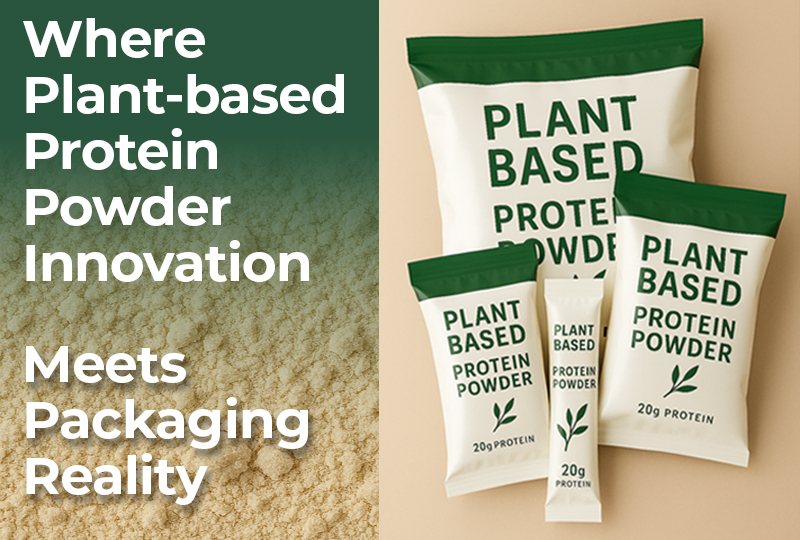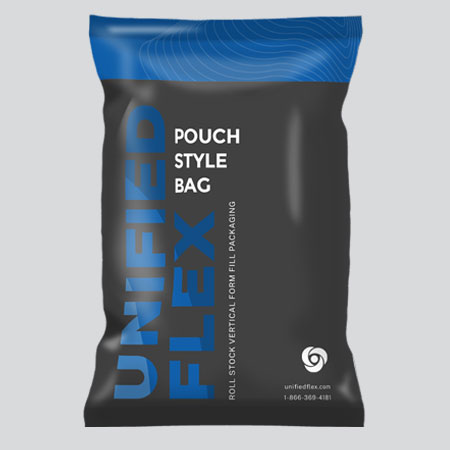From Film to Format: Rethinking Plant-Based Protein Powder Packaging

Where Protein Innovation Meets Packaging Reality
The plant-based protein market isn’t slowing down. From pea and rice blends to oat and hemp formulations, vegan protein powders have become a staple in both athletic and everyday nutrition. But while the spotlight often falls on ingredient innovation, the quiet revolution is happening in packaging.
Unlike traditional whey, plant-based protein powders are notoriously difficult to package. They’re light, fine, and cling to everything. They absorb moisture quickly and can lose flavor or texture when exposed to oxygen or light. The result? A product that requires smarter protection, starting with the packaging film and format.
Modern brands are turning to flexible packaging, ranging from 3-side and 4-side seal sachets and stick packs to pillow bags, not only for cost efficiency but also for sustainability. These formats reduce material use, improve storage density, and align with consumer demand for convenience and environmental responsibility. But achieving all that requires precision engineering, both in the packaging material and in the process behind it.
The Challenges of Plant-Based Protein Powder Packaging
Packaging vegan protein powders is as much a materials science problem as it is a mechanical one. Their physical and chemical properties demand tighter process control and better barrier protection than most traditional powders.
1. Moisture and Oxygen Sensitivity
Plant-based proteins are hygroscopic, they naturally attract moisture from the air. A slight increase in humidity can cause clumping, flavor loss, and reduced solubility. Oxygen exposure can also degrade fats and proteins, dulling flavor and color over time.
2. Fine Particle Flow and Seal Contamination
Vegan protein powders have a soft, airy consistency that creates dust during filling. These fine particles can get trapped in the seal zone, causing leaks or weak seals if the film and sealing temperature aren’t properly controlled.
3. Sustainability Pressures
Consumers want packaging that’s recyclable or uses less plastic. But films designed for recyclability, like mono-material laminations, have narrower sealing windows. They demand tight control of temperature, dwell time, and pressure to ensure reliability.
4. Portioning and Efficiency
Today’s consumers want flexibility, single-serve sachets for on-the-go use, stick packs for sampling, and larger pillow bags for pantry storage. Each format must maintain the same freshness and quality standards, regardless of fill size or film structure.
Overcoming these challenges starts with what’s often overlooked, the film itself. Before machines can perform consistently, the packaging material must be engineered for stability, sealing precision, and barrier protection. That’s where film science becomes the foundation of every successful run.
Film Engineering: The Foundation of Freshness and Sustainability
In plant-based protein powder packaging, film performance determines product quality as much as formulation does. These powders are sensitive to oxygen, moisture, and light. The right film structure must block those elements, seal cleanly under variable conditions, and run reliably at production speed. There’s no one-size-fits-all answer, only the right balance of barrier protection, machinability, and sustainability.
High-barrier laminations are the first line of defense against degradation. Their multi-layer construction combines materials like EVOH, PVDC, HDPE, and Alox coatings to limit oxygen and vapor transmission. That protection helps plant proteins retain flavor, solubility, and shelf stability. Foil versions deliver total light protection, while clear variants maintain product visibility without compromising barrier performance. Each layer is engineered for a specific job—one for strength, one for sealing, one for barrier. Together, they create a stable environment inside every package.
For extended shelf life or high-value formulations, metalized laminations add a reflective layer within the film—typically aluminum—that reinforces the barrier. This design prevents light and oxygen intrusion even under long-term storage or transit stress. Metalized BOPP, BoPET, and polyester laminations combine durability with rigidity, helping finished bags maintain structure while seals stay tight. Beyond protection, the metallic finish also enhances print contrast and premium appearance without adding excess material or weight.
When efficiency, speed, and cost control drive production, polypropylene-based films deliver reliable performance. OPP and CPP laminations provide dimensional stability, moisture resistance, and clean sealing at high line speeds. They run smoothly on forming collars and sealing jaws, maintaining pack uniformity and reducing film waste. Their clarity and stiffness make them a practical choice for sachets, stick packs, and pillow bags that must balance throughput and presentation quality.
Each material solves a specific problem. High-barrier films fight humidity. Metalized films handle light and oxygen. Polypropylene-based films run fast and clean. When selected for the right application and paired with precise temperature and tension control, these structures extend shelf life, maintain product integrity, and reduce waste across every run.
Once the film structure is optimized for barrier performance and machinability, the next decision is format. After all, the film only performs as well as the packaging geometry it’s shaped into.
Choosing the Right Packaging Format
Selecting a packaging format for plant-based protein powder is a matter of function, not aesthetics. Each format supports a specific handling requirement, how the product flows, how it’s stored, and how the end user consumes it. The goal is to protect the powder while maintaining a consistent, efficient process.
Sachets are ideal where portion accuracy and controlled exposure are critical. Single-serve applications, such as samples or travel pouches, benefit from this format because the reduced volume limits air contact once opened. When produced with high-barrier or OPP films, sachets maintain the balance between product protection and line efficiency, running cleanly at small fill volumes without excess material waste.

Stick packs extend that efficiency further. Their elongated shape reduces film consumption per unit, making them a practical choice for high-volume production where sustainability and line speed are priorities. With properly tensioned metalized or OPP laminations, stick packs maintain seal integrity even under the fine dusting common in protein filling operations. The narrow geometry also supports accurate dosing and efficient secondary packaging.

For larger pack sizes, pillow bags provide mechanical stability and throughput consistency. The standard three-seal structure, one vertical and two horizontal, distributes stress evenly and resists deformation during storage and shipping. When made with high-barrier or metalized films, pillow bags prevent moisture ingress and oxygen exposure, preserving shelf life for 250 g to 1 kg fills commonly used in retail and foodservice formats.

Each format reflects a different operational need: sachets minimize exposure, stick packs optimize film use, and pillow bags support bulk handling. Once the right format is chosen, the next challenge becomes how efficiently and sustainably it can be produced.
The Sustainable Edge: Efficiency Built into Design
Packaging format must align with today’s sustainability expectations. True sustainability in vegan protein powder packaging is about more than recyclable materials; it’s about reducing waste throughout the packaging lifecycle.
That starts with precision film control and continues with efficient filling and sealing operations. When barrier films, seal temperature, and motion control are aligned, packaging becomes more predictable. Fewer leaks mean less product waste. Stable sealing windows allow thinner, downgauged films to perform reliably, lowering plastic usage without sacrificing protection.
Every layer of optimization, from film gauge to sealing precision, helps brands reduce their environmental footprint while maintaining quality standards.
Achieving that level of consistency isn’t theoretical; it’s engineered. Modern packaging systems bring these sustainability principles to life through servo motion, temperature precision, and validated sealing logic that keeps every run repeatable and waste-free.
Engineering Precision for Real-World Performance
Vertical form fill seal (VFFS) machines are designed to maintain this balance between performance and protection. Servo-controlled motion ensures smooth film handling. Precise temperature regulation keeps sealing consistent even under fluctuating plant conditions. Integrated feedback logic automatically adjusts dwell time and pressure to match film composition.
For flexible formats like stick packs, pillow bags,3-side and 4-side seal sachets that consistently translate into fewer rejects, faster throughput, and packaging that protects both product and brand integrity.
In plant-based protein packaging, where fine powders meet sustainability demands, precision engineering isn’t optional; it’s the difference between meeting spec and exceeding expectations.
Conclusion – The Material Difference
In the world of plant-based protein powder, packaging is more than protection, it’s performance. The right combination of film and format determines how well the product resists moisture, retains flavor, and meets consumer expectations for sustainability.
High-barrier, metalized, and OPP laminations each bring unique advantages to sachets, stick packs, and pillow bags, creating a flexible ecosystem that supports both shelf life and sustainability goals. But none of that performance happens by chance, it’s engineered through the precision of modern VFFS systems that align film, format, and sealing in one seamless process.
Ultimately, packaging defines the product experience long before a scoop hits the shaker. It’s where material science meets mechanical precision, and where sustainability meets performance. The right packaging doesn’t just protect what’s inside the bag; it defines how the brand performs on the shelf, and how long it stays there.